Interview: Nico Vouilloz Goes Down the Rabbit Hole on Bike Setup & Design
"In this period I was a winning machine." I'll never forget Nico Vouilloz telling me this a few years ago. We were sitting outside a restaurant in the middle of a press launch and the thing that still makes me laugh today is how matter of fact he was about. There was no bragging or bombast, it's not his style; he spoke softly and merely stated how things were. His records in world-class DH will probably never be equalled. While the commentators may point out that Minnaar, Peat and Gwin all have more World Cup wins, what is missing from that picture is that Nico retired at 26. That's the same age Bruni is now. Nico took 16 World Cup wins, 5 overalls and 10 World Championship titles in just 11 years (at that time you could compete in the junior field at 15).
He was always famous for how utterly maniacal he was about his bike setup and performance, and that his feel for how a bike can and should work is still unparalleled. There is a story a top EWS rider passed onto me a few years ago of Nico not winning because of a problem with his rim. The story goes that on the Monday morning after the wheel designer had an email from Nico waiting for him with a full CAD drawing of the rim he needed to win next time. These days he has turned that focus to bike design for Lapierre's mountain bike and e-bike ranges. I was lucky enough to sit down with him and what was supposed to be a quick bike check of his Lapierre GLP2 race ebike turned into this...
 So, this is the bike you won the French Championship with last year?
So, this is the bike you won the French Championship with last year?
Yeah, more or less. It's exactly the same, except for the color. But it's the same bike, yeah. Just the frame was raw finished at the nationals, but exactly the same spec, really same thing.
 I was going to start with the general stuff. How tall are you?
I was going to start with the general stuff. How tall are you?
I'm 176 cm.
 And you went for the size medium frame, which is 455mm reach. Because then what's it, 480mm for the large, and 420mm, 430mm for the small? What's your feeling on reach in terms of your optimum reach?
And you went for the size medium frame, which is 455mm reach. Because then what's it, 480mm for the large, and 420mm, 430mm for the small? What's your feeling on reach in terms of your optimum reach?
With the previous bike, I was always a bit in between medium and large. So I made this one a bit longer in terms of reach compared to the previous one for the medium. So that's why it's 455mm. Before it was 440mm for the medium. So I made it longer because I was in between. But also, because for climbing uphill the weight distribution is really in the center. The chainstays are short [editor's note: for an ebike], it's 440mm. The idea was also to have a longer front to have more weight on the front in uphill, so it doesn't wheelie too much. So I stay riding the medium. For my job at Lapierre, I also tried the large. It should be 480mm reach. It's long. It's a bit too long for my size and my style, it's harder for me to put weight on the front and to feel the grip. I'm not comfortable enough.
 Some of the brands that are pushing much further in this direction. If you look at, say, Pole, 480mm is a medium in the Pole range. To what extent have you played with longer reaches, and where do you think your limit is? Why do you think that is your limit?
Some of the brands that are pushing much further in this direction. If you look at, say, Pole, 480mm is a medium in the Pole range. To what extent have you played with longer reaches, and where do you think your limit is? Why do you think that is your limit?
First, I could say maybe I didn't ride the bigger bike enough to get comfortable on it, because I didn't see any benefits. Especially on the ebike which is heavier. So it's heavier, it's more stable. I think you have a bit less need for stability than with a normal bike. Then talking about longer and longer, yeah... I have the feeling that you have two ways to think about this. If you are not really a good rider, probably a long bike gives you more confidence. But it is a bit more complicated to turn. And when I say turn, I'm not talking about hairpins. In hairpins you can place your bike. It's super tight. You can always move your bike a bit if you have some skills. If not, if you are not able to move a bit your rear wheel to place, okay.
But it's not really in hairpins that you have a problem and trouble when you have a long bike, it's more while cornering on normal turns where I wasn't feeling comfortable with the weight distribution. I had the feeling I was turning slower on a normal turn. If I had to change my direction quickly like you do in enduro, you have to react and if it's too long it's just delayed. So I think it's always a compromise. Maybe now I'm thinking also longer rear to go with the longer reach. It's what I will try soon on some prototypes. But 440mm is not really short. So that could work... Maybe if I spend one month on it, I say, "Oh yeah, I see another benefit." But for now, when I try longer bikes, I just see the downsides. And maybe we must go a bit shorter to ride with a bit slacker head angle, compared to long and not too slack. I like it when the head angle is around 63 degrees, 62.5, 63, 63.5. But no more. I don't like it if it's more.
 How come you haven't gone for that head angle on the production bike?
How come you haven't gone for that head angle on the production bike?
I try to design a bike that isn't too extreme for everyone. So it comes with a 65-degree head angle with a 160mm fork. I'm riding a 170mm fork plus a half degree angle-adjust headset. I should do that, maybe? I should go really on what I like, but I also always try to balance a bit and not be too extreme because it depends where you ride
 Well, I always wonder with these things, is it a question of taking the public on gradually so maybe the next bike you can push a bit further?
Well, I always wonder with these things, is it a question of taking the public on gradually so maybe the next bike you can push a bit further?
Gradually, and also you have to think about where you are riding. Also, the better level you have, the slacker you like because you like to go into extreme things, deep. But if you don't really have the level and you're not riding technical and steep tracks having such a slack angle, sometimes it's a bit lazy. The bike has the feeling of falling into the corner. So yeah, it's always a bit of compromise. Honestly, I'm not far from the production bike and the next year the production bike will have a 170mm fork, so globally it will be like 64.2 degrees, something like that. And it will be good.
 Going back to reach, because I'd have thought that if you start calculating the effective reach after you've changed the fork and added the angle adjust set you're probably close to 450mm then for the effective reach.
Going back to reach, because I'd have thought that if you start calculating the effective reach after you've changed the fork and added the angle adjust set you're probably close to 450mm then for the effective reach.
Yeah. You make it a bit shorter. Of course. Yeah. I don't know exactly how much, 10 mm? Maybe two, three mm on reach maybe?
 I'm curious what you think about chainstay length, because between Spicy got down to 428mm on the 27.5 version.
I'm curious what you think about chainstay length, because between Spicy got down to 428mm on the 27.5 version.
It's 425mm on 27.5 and a 430mm, 435mm on the 29.
 Did you consider going to do like kind of different chainstay lengths for different sizes? Because obviously, if you were riding the medium then the chainstays developed around what was ideal in relation to that reach.
Did you consider going to do like kind of different chainstay lengths for different sizes? Because obviously, if you were riding the medium then the chainstays developed around what was ideal in relation to that reach.
I'm thinking, yeah I probably will. I launched some prototype on Excel with longer stays, not on this one, but it's something for me, it looks... not obvious, but it's the philosophy I like. I like longer, and especially when you are tall, you are sitting more on the rear. And so you put more weight on the rear, even if you have a steep section, but it's ok as you have big legs. Your overall weight is a bit more on the rear, so I think you need a longer rear as well. I think we saw this need because we are increasing the reach more and more. And we saw that it is hard to feel the balance between front and rear. So we are thinking, okay, we have to increase the chainstay. The problem at the end, I think. Okay. The balance will be good, but to have a playful bike, I'm not sure it will be easy. Because long front, long rear, okay cool, bike is balanced, you can feel your grip, but maybe it's a lazy bike...it's good to go straight. It's good also to have a fun bike. There is efficiency which can make you a smile, so can having a playful bike, it's cool too.
 What's the BB height?
What's the BB height?
It's 340mm. It depends on the fork and everything, but it's... I don't know if 337.8mm Or 342mm. Maybe we could check after, but it's around that. I'm riding 160 mm cranks.
 160mm cranks?
160mm cranks?
160mm, yeah. So a bit short, just to increase the uphill capability.
 When I saw you on the first prototype in September you had a MegNeg air can on your bike.
When I saw you on the first prototype in September you had a MegNeg air can on your bike.
Yeah, I didn't really like it at the end because of its effects from the middle to the end of the stroke, even if it's supposed to mainly affect the middle. But I had zero tokens in a positive chamber and maybe it was a bit too firm at the end. The thing is, when you ride in our area in the rocks, in the rock gardens, when it's too firm at the end, then you get quite a big impact when you're riding fast, BAM, on the old Roman trails and then the bike stops.
I'm now riding with a firmer setting, and I have a medium setting for compression. So nothing really special. I just have the new piston from RockShox. It's something I'm trying, maybe to give me a bit more flow on high-speed sections. It doesn't really affect big impacts. But it's close. So medium, then for rebound I have the linear one. They it's called something like the racing rebound.
 So it's quite light rebound.
So it's quite light rebound.
What I lost with the compression being firmer, I tried to get it back with a bit faster rebound at the beginning of the stroke.
 Before we go too far down the suspension rabbit hole how much do you weigh?
Before we go too far down the suspension rabbit hole how much do you weigh?
70 kg.
 Okay. And so then what are your pressures? You mentioned 30% sag at the back, do you know what pressure that is?
Okay. And so then what are your pressures? You mentioned 30% sag at the back, do you know what pressure that is?
It's 190, 185psi.
 And then do you have tokens in there as well?
And then do you have tokens in there as well?
It's 2.5, yeah.
 So that's the one Gnardog token, the big one?
So that's the one Gnardog token, the big one?
Yeah.
 And then in the front you have?
And then in the front you have?
In the front I'm riding the new air spring as well. With the new piston, the Debonair 2. And I'm riding 80... between 80 and 85psi depending on the course.
 What kind of sag does that give you?
What kind of sag does that give you?
I don't know. Honestly, I never look at my sag. It's really all about the feeling.
 What compression are you running?
What compression are you running?
Between five and eight in from closed.
 So quite a stiff compression setting?
So quite a stiff compression setting?
It's balanced. I try to add some compression, so I'm not fully open, for sure, especially with the ebike. But if you try to do too much compression then you have to remove the air. Okay, fine, you have less pressure. For me, it doesn't cover everything you can find during a ride. If it's steep and not so fast, then you're really missing something. If it's steep but you have some speed, even if you're missing a bit of air, the speed means that you use the hydraulic side to help the bike to stay high. But sometimes you can have a row of steps that are slow and steep. And then the hydraulic side, when the bike starts to dive if you have no speed, you stay down. That's where you need the air to help you stay high. So doing the two extremes, quite hard on the air side and no hydraulic support, sometimes it's the easiest way to find something to be confident in, I mean, so you stay high. But then sometimes it's diving too because you have no hydraulic support. It's quite a balance with the hydraulic side.
 How do you find that for racing? Because as I understood it, if you tend to lean too much on the hydraulic side, when it starts getting hot and the oil starts getting thinner, you start losing damping. When the air heats up it gets stiffer, so it's maybe not comfortable but it's still rideable, whereas if the hydraulic starts to fade and your fork is diving all the time then that's harder to ride.
How do you find that for racing? Because as I understood it, if you tend to lean too much on the hydraulic side, when it starts getting hot and the oil starts getting thinner, you start losing damping. When the air heats up it gets stiffer, so it's maybe not comfortable but it's still rideable, whereas if the hydraulic starts to fade and your fork is diving all the time then that's harder to ride.
I don't really get this feeling, maybe it's with my weight. If I have too much hydraulic, first I end up too much on the downhill side of setup and not enough enduro. So when there are rolling rocks, slippery lines, then the bike is harder to ride, it doesn't absorb too much. When you get fast impacts and you ride fast on rocks, also the hydraulic can become too stiff on high speed, and then it's harsh as well. And if you have too much compression, you also need to open the rebound. Otherwise, same. It's not enough for repeated hits. So you need to compensate a bit.
 How many tokens do you have in the fork for them as well?
How many tokens do you have in the fork for them as well?
I don't know if I should say because I'm using the Formula Neopos.
 How many of those have you got in there?
How many of those have you got in there?
I have one. With the new air side, I'm riding one token or two. Less than before. Before for sure it was two or three. And now it's one or two, or one foam. But I need to test again. For the foam, it's never so clear. You always need to test.
 Have you tried running the Neopos in the shock, as well?
Have you tried running the Neopos in the shock, as well?
Yeah, I tried it. I think the foam, it's maybe too soft to put on the rear with the pressure. And I am not convinced for now from what I try. You get more support in the middle, maybe. But then it's linear at the end, and you bottom out. So with tokens, you can ramp up it a bit more. And then like the foam, maybe it's too soft. It made the shock a bit too linear. And if you just add them with the 2.5 tokens... I didn't find the right balance.
 In terms of progression, do you try to get balanced progression front and rear, or does there tend to be a difference? Like maybe a more linear rear and a more progressive front?
In terms of progression, do you try to get balanced progression front and rear, or does there tend to be a difference? Like maybe a more linear rear and a more progressive front?
Until now I was riding, I think, a firmer front than rear. But the same with ebike, with the weight, I'm really trying to increase my compression, my sag, before I was softer on the hydraulic side and I was riding 32% sag. But in the uphills, or if you're on a more bike park-style track, or more downhill track, with rock steps and everything, I think I need more compression. My goal is to balance, try to balance my bike a bit better for all-round. For now, I'm sure I have a faster bike. And when I go in the rocks, and on the really slippery sections, I didn't have time to test with the lockdown, really. So I don't know if I just need to keep the setup and just increase the rebound and add a bit more sag.
My bike is a bit too difficult to ride for the pure enduro stuff. For racing, I feel the bike is fast, but also, sometimes, a bit demanding compared to what I was riding before. Like it was easy to ride if it rains and it's slippery, but then I was bottoming out also. Then it's a bit too soft in the uphill, and I am stalling because I don't have enough support. I would like to not have two shocks. I tried with one to be able, just with some clicks and two or three per cent difference in sag, to have the right things for bike park stuff, and then for pure enduro. And imagine when you have a bike really stiff then it's super hard. But I also see the benefit, and when you have a firmer suspension, you come into a rock garden sometimes and the bike just goes. It's not moving left or right or getting too low in the travel, and just get the impact in your rim, or you get a flat because you are too soft. So it's we don't have one truth, it's always test, compromise, balance, and nobody for now knows.
 You're running the Zipp carbon wheels in 27.5 rear, 29 front. How much have you played with 29 on the rear as well, because I know you were generally running 27.5 the last few years, weren't you?
You're running the Zipp carbon wheels in 27.5 rear, 29 front. How much have you played with 29 on the rear as well, because I know you were generally running 27.5 the last few years, weren't you?
Well, first I can't really put a 29" wheel on this bike at the rear. I can, but I have nothing to compensate so it's super close. You have just two millimeters depending on the tires, and the BB is a bit high.
 Sure. I was wondering what the deflection on those wheels is going to be because I was watching the videos of Adrien [Dailly] the other day, watching his wheels corner, and you see how much flex there is in those wheels.
Sure. I was wondering what the deflection on those wheels is going to be because I was watching the videos of Adrien [Dailly] the other day, watching his wheels corner, and you see how much flex there is in those wheels.
Yeah... For me, the flex is going in the right direction. Well, I didn't notice really that. I think it's more our bike. We wanted some flex at the rear to have an easy bike to ride. We try to be really stiff around the BB, stiff as we can, but on the rear we try to be not too stiff, to leave enough give for slippery off-camber roots. So that can come from the wheel, but also from the frame.
 So in terms of stiffness, would you consider running a 38mm fork on that bike? Or would you stay with a 35mm fork?
So in terms of stiffness, would you consider running a 38mm fork on that bike? Or would you stay with a 35mm fork?
Yeah. I didn't have time to really try it well... I like both. It's my problem for now. I like the 35 and how it's easy to ride and how comfortable it is on the long runs, because sometimes we have long runs, like eight, 10 minutes riding, and are you are happy with that. But it's missing a bit of stiffness, even for my weight. And especially because we have a 170 or 180mm travel with a 29 fork, we try to be on the edge in terms of the length and overlap with the lowers and everything. So the 38 looks promising for that for sure. But right now, you also think it's maybe too stiff. I'm light also. In repeated hits, I really see that it's more precise. It's more the downhill side. You have the feeling of having a bigger bike. You can go harder.
But at the end, maybe when it's really loose when it's long, I don't know if the benefit is lost on that. But for sure, for a heavy rider, there will be no doubt. Honestly, up from 75 kilos, for sure, the benefit of the stiffness will be better, because if I feel we are on the edge with the stiffness with my weight and my ride style, I think people who are pushing more and are heavier, for sure they will be super happy with it. When you are a bit in between maybe it's a bit more work, on the 38 the fork always needs to be perfect in terms of a function. So more services to always have something fresh.
 Because with the extra rigidity you'll notice that more?
Because with the extra rigidity you'll notice that more?
Yeah, if you ride too long and then you notice that there is a bit more friction plus the stiffness, it starts to be firm.
 So you deliberately chose 27.5/29 for this bike. Have you been playing with the different wheel sizes much?
So you deliberately chose 27.5/29 for this bike. Have you been playing with the different wheel sizes much?
Yes and no. First I made the bike like that to make it more playful. But at the front, I came back with a 27.5 and, yeah, efficiency and grip, 29 is better on the front. Maybe where I'm not happy is when the bike is carrying speed and you have to change your line. Sometimes with the inertia of the front wheel and tires and everything, I notice I have too much difference in between low speed and high speed. So it's what I didn't like with the 29, but it's so easy to control when you carry speed that it's good.
At the rear, I tried the 29 on this one just to see, because this bike is quite light and easy to handle. I wanted to see, even if it's not made for that. On the straights it was even better. It's even more stable, even more, everything. To place it into the corner the 29 wheel needs a bit more effort when you need to move, to turn. It's less than at the front. You have less difference, but you feel also some inertia at the rear, and also to play into the corner, it's a bit more... There is a bigger wheel at the rear. You feel it a bit. And with my size, again, if it's steep... You need to be centered into the bike. And if you forget that, or sometimes you touch your ass on the wheel, you feel it. It's right there. So you have a bit less space, you can move a bit less on your bike. It can be a bit more physical when you ride steps and long descents because you really have to stay more in the middle of the bike.
Regarding the wheel. I really, really, really like how it works. I really notice that it's an improvement in terms of absorption. It's a first for me, the first carbon wheel that really brings something. And for sure, it's not too stiff. It's even softer for me than an alloy rim. So I liked the first feeling I had on it. They are really good. Width is good in 30mm, and you see some flex, for sure it's not a stiff wheel. But again, I need to compare back-to-back because of the difference when I tried it was so obvious, but maybe too much. Sometimes you are excited, you say "That tire!" So I need to try again to see if the gap is so big, or it depends on the track. And I always like to take a step back to be sure, because I was so excited when I tried it back-to-back one day that I stole it from Adrian for the national champs because I really liked it. But I would like to double-check...
 So what are the little touches then? The little things that you're a maniac about on your bike, because if we start at the cockpit and work backwards.
So what are the little touches then? The little things that you're a maniac about on your bike, because if we start at the cockpit and work backwards.
Well, first I have some wrist problems. Crashing, again and again. So one of my wrists is really bad, so I really pay attention to the grip I put on my bike, and I need something with quite a thick pattern, But I don't like big grips, I always rode with a small diameter. So to compensate, I cut the Oury below, because I have the wider section on top that is quite thick. But I reduce a bit the diameter for my finger below where I don't need a big grip. So it's quite important. I have the AVS guard for the bushes, and even for the look, I like the enduro-style it brings.
 So for when you're cheating going off the course?
So for when you're cheating going off the course?
Like the French line? It's for that [laughs]. Yeah... So, no, but when you ride and it's wet and the bushes and everything come into the track, it's cool. Then my brake levers, I think a lot about my lever position, it's quite important for me. They are not set at the same height because my front brake needs to be lower for my wrist. Because if I put too much angle on it, it hurts, so I need to be a bit lower on the left to be more in line with my arm. Then I'm sitting at 760mm wide bars. I was riding 780mm, but in the trees, I found 760mm the best compromise.
 What stem length are you running?
What stem length are you running?
Right now I'm 35mm, but I normally go with 40mm. I tried 45mm, but it was too much. And then in the steep things, I don't like it. So, I will say 40mm, it's a length I like. With the ebike, you need to feel a bit differently as well. So, but it's 35mm on this one. My rise is quite high, 30mm. It's more to reduce the spacer below the stem. I don't like how it looks with too many and it doesn't look good. I have already a few spacers, so, if you had 10mm more, it's not nice.
 So, can you feel the rigidity difference then between the number of spaces on the stem?
So, can you feel the rigidity difference then between the number of spaces on the stem?
No, no.
 I'm just curious how sensitive you are?
I'm just curious how sensitive you are?
I feel the difference between a carbon bar and an alloy one. This I feel, and I'm riding alloy. I can't ride with vibration and how stiff carbon is. Is not a problem, for example, for Adrien [Dailly]. He's young. But for me, carbon bars... I feel it. I really need alloy on the bar. Yeah, otherwise nothing special on the cockpit. I set my shifter a bit lower than the standard position on the AXS.
 Yeah, the grip tape on the paddles as well.
Yeah, the grip tape on the paddles as well.
Yeah. It's more to be a maniac when I'm preparing my bike for racing. I like the details. It gives me the feeling to be ready and everything is prepared. I also test all the offset of the forks possible. So, I have the smallest one right now, but I think come back a bit. So, there is 37mm, 42mm, 46mm, 51mm. I tried everyone with a 29 wheel, with different head angles. And I came back to 42mm, 46mm. So, on the next forks are 44mm, I think, and it's quite good.
 Can you explain what the difference is between the offsets? Because there's a lot of discussion as to whether it is actually worth changing the offsets for most people?
Can you explain what the difference is between the offsets? Because there's a lot of discussion as to whether it is actually worth changing the offsets for most people?
First, you adapt quite quickly. Even if it's 42mm, 46mm. Okay, you notice a difference, but then you adapt. So, nothing is really wrong. I mean, you can change for your pleasure, but you don't have something shit. Okay, 51mm, maybe it's the one I didn't like. But it also depends on the length of the bike. There are many parameters. It's why there is a big discussion because it's not as easy as, "Okay, more offset." So, 51, you have a longer bike, but you also change the neutral position, you know?
 What was the problem with 51mm for you? Just a feeling?
What was the problem with 51mm for you? Just a feeling?
Yeah, a feeling and into tight turns. The wheelbase is longer and it's a bit more sensitive at the neutral position. On tight turns with the more offset, you feel more off the front. If if hit something at slow speed, I did not like it. I put 51mm on the 27.5 wheels and it's too much, it's out of control. It's super sensitive. But one time on the track, I put on 51mm. I had the feeling my bike was a bit short, so I felt the benefit of making the bike longer. So, it reversed my mind a bit. I was convinced that it was not really good, even at high speed to have too much offset, but then I feel that I have more wheelbase. So, since that, I'm back to being a bit confused again, because decreasing at the extreme, like 37mm, is not made for 29.
With the RockShox, it was 37mm, 42mm, 47mm, 46mm, for 27.5. And 42mm, 51mm, for 29. My opinion is it's more 37mm, 42mm, for 27.5, 46mm, 51mm, for 29. So, again, I had the feeling that the GLP2 was a bit too long in reach and I like a slack angle. I put one degree more at the head angle, then I put 37mm on to try just for the wheelbase. It's okay.
My feeling is I have some problems feeling my grip at the front now. With the bike a bit too slack and with the 37mm, I'm not confident to feel the grip or to put weight on the front. It doesn't bring the feeling I was expecting and it was a bit lazy when it's fast. So, it's always the little things. So I went back, added degrees to the headset and I put 42mm on again. I always come back to 42mm. Stem also affects this because we are talking about offset, head angle and stem length, you also have bar height too. You have your wheelbase, offset, the head angle and the stem length, it's a bit all these four things. It's why nobody is talking about this a lot because you can try maybe one offset, but the bike for you is a bit too long. Or you don't have enough head angle or your stem is a bit... For me, again, it's always a balance and the little things can bring you a bit more confidence at the end. Because maybe you put five mm more below the stem and then it changes a bit and you feel it, and again, you change your mind a bit.
 People seem to talk about mountain bikes in terms of individual components, not as a whole system.
People seem to talk about mountain bikes in terms of individual components, not as a whole system.
Yeah, it's like, you say, "Oh, shit, my suspension at the rear is packing down." Or I'm riding and bang, I get an impact. And you say, shit, high-speed compression is not good. And then you remove a click at the front and then the rear is working better, for example. It's quite global things. But then I saw that you have some rider really on the back with stiff legs and then they are demanding too much of the rear. So, they need to be more stiff because... It's why we are always in testing, improving, but it's a global package.
With frame stiffness, too stiff is not good. They brought in alloy frames in motocross and it was way too stiff. You know? Carbon frames can be really stiff, but so can alloy. And at the end, it's not good. Too soft, then your bike is not stable at all. I did some tests with a soft frame, or soft rear when it's too much. When you have some speed, you hit holes and everything and you have the feeling your bike is not stable, just imprecise and unstable. You are always trying to compensate and you don't feel comfortable. And you have a stiff bike "Ok, cool, super stable," but then when you arrive in turns and it's not coming in easy. It's not natural to turn because it's like a piece of wood. Then you are thinking, "Shit, lower my tire pressure, put my suspension setting lower because everything feels too stiff." And it just came from the frame. So, again, balance in between stiffness, the right stiffness in the right place. It is not "Stiff is better," no.
 Generally carbon frames through mountain bikes have been marketed "This is a stiffer frame". I've always wondered if there's a material restriction; if you have carbon, it has to be stiff. But is it just a question of engineering it in a certain way?
Generally carbon frames through mountain bikes have been marketed "This is a stiffer frame". I've always wondered if there's a material restriction; if you have carbon, it has to be stiff. But is it just a question of engineering it in a certain way?
Yeah. Also, the material you are using, because you have different carbon fiber qualities and that brings a different feeling. On the Spicy and on this bike, we tried a few different ones. Especially because at the beginning we were not stiff enough. So, we first needed to increase the number of layers, but with the same qualities. But we added weight and it was not good. And then we said, "Okay, we go for better quality, more expensive material." And that's the prototype frame and it's stiff. So, when I got it, I was quite happy, but we had to come back, well, I can say for price because I got the frame and I said "Okay, that quality of carbon was too stiff," you are more precise, but when it bends and rebounds, it comes back really fast.
 Kind of really aggressively?
Kind of really aggressively?
Yeah, aggressively. And then it's hard to ride. And it's why my prototype was made with this quality. But I didn't race with it, and now the series bike has the right quality carbon. And I'm waiting, they should arrive at the end of the month. I'm riding with my prototype, just because I set my suspension for this frame quality because that affects the setup too. Now, if I ride my last setup with firm settings, it's too firm. Think about a road bike. When you have this fast rebound on a road bike, you are happy because you have the feeling to have some more power. If you have a road bike that is super, super stiff, then you don't have this, you are not able to move it and then you had the feeling is a bit dead, too stiff. So, if you are riding a Pinarello, you are punished and you don't have enough power either. It's what I think from what I try. So for the materials in their quality, property, or their inclination and it's test, test, and test and learning and learning.
 Is that an argument then if you're going to buy carbon, you need to get a high-end carbon frame because you're not going to get that same material quality at the lower end?
Is that an argument then if you're going to buy carbon, you need to get a high-end carbon frame because you're not going to get that same material quality at the lower end?
Just an example. I tried the Scott Spark cross-country frame with high-end fibers, super stiff. Not easy to ride. For a cross-country bike, it's really hard to ride. Yeah, not for pedaling, for pedaling it's whoa! We are working on a cross-country bike, so, I wanted to see the reference in cross-country. So, high level, the highest price, €6,000 with the stem, everything. I don't think it is bad. I didn't say is bad...
Just I know what carbon they are using. And you can feel that it's stiff, but it's a bit nervous, it's a T1000 fiber they are using. But they are the reference in cross-country so it's our target. I also tried an Orbea cross-country bike, who are normally a reference, but it's soft for a cross-country bike, it's not stiff around the BB. It's not made in the same place. So, just to answer, maybe super high end. I'm not sure if you have the right bike for enduro or an easy bike to ride. I'm not sure it's with the highest end of fiber you get better handling. I'm not sure.
 From what you've said though, you had to get the more expensive fiber to get the feel right for the GLP2 though?
From what you've said though, you had to get the more expensive fiber to get the feel right for the GLP2 though?
Yeah, because we were focusing on stiffness. And we said, "Oh, we put a bit higher quality fiber in." And we did two more. So, it was maybe the third prototype when we said, "Please do a full bike with this high-end fiber." And so I try. I say, "Oh, yeah, yeah, for sure I can feel it, it's way better." But then when we discussed price... As we wanted to be able to sell the bike, so okay. Okay, they told us they could come back with an in-between material. I was really not convinced. I pushed to keep the higher end fiber, but when actually I got the bike, I said, "Okay." It rebounds slower after deformation. And I really love how it reacts less quickly than with the higher quality fiber. It was maybe moving less, but it was coming back quicker. I really feel the bike was working much better, in terms of suspension and even how stable it was when it was the deforming. It was just easier to ride. And I learned a lot.
Like I say, we always learn.
 We should probably finish the bike check. right? The next thing is just the battery compartment here.
We should probably finish the bike check. right? The next thing is just the battery compartment here.
The concept of this bike is just to have a light bike, and I continue to push the boundaries and cut a few things... It's difficult to sell it like that, but I just cut the alloy plate and it in two and keep the minimum.
 Does that affect its weight or its stiffness?
Does that affect its weight or its stiffness?
No, no. It's not for the stiffness. It's really to save 70 grams or something like that. 80. Yeah. But it's 100g at the crank... and at the end, when you are thinking like that, you get 300-400g and you are to be almost half a kilo less.
 What is the weight of this bike?
What is the weight of this bike?
Around 21kg, depending. For national champs it was at 20.7kg, but the tires were smaller.
 So, why did you cut the cooling fans down on the motor, is that weight?
So, why did you cut the cooling fans down on the motor, is that weight?
No, no, I didn't cut the cooling fins, I just polish them. It just polish to let the people think that I have a special engine [laughs], "Shit! He got something from...", but no, it's just different. I cut the bash guard, just for more airflow a bit, but also for mud getting out and not getting stuck into it. I worked on the derailleur spring because it was a bit soft. There was a bit of chain noise.
I don't like noise, so, like many people, so I try different things. I'm working on the brakes a lot because I'm coming back from the Shimano ones and they are working differently. The Shimano is quite aggressive, maybe a bit too much, but it's quite aggressive and not super for endurance. This one is not aggressive, but great for endurance. But the feeling with the Shimano, where as soon as you touch it, it brakes, it's missing a bit, so I try with a bigger rotor to get it. I try different combinations to try to get a bit more feedback from the ground with a bit more aggression. I'm running 220mm discs, a little because I like how it looks. I don't know, maybe I will come back 200mm.
I'm still testing pads just because I switched from Shimano to SRAM, I really see what was good on one and bad on the other. I found out what is bad on the Shimano, the lever feel changes sometimes, it is not perfect and the SRAM as well. So I said, "Oh shit, I can also work on that because there is something I can find to be more confident with." I don't like when the brakes are too aggressive because sometimes it's slippery when it's wet and everything. So I don't like on/off brakes. I don't like the parking brake. But... I also don't like it if it's too progressive, easy to control, but just missing that something to feel the terrain on the ground.
I was generally quite happy with the brakes and I'm really happy because you can do long runs with no trouble. You arrive into the corner, you push more on the lever, you have more brakes. So it's good. Just missing a bit. So, that's why I tried different combination of levers, like a Guide Ultimate with a Code caliper, the new one, a guide RE and the old one guide. For now, I liked the Guide Ultimate lever and the old Guide caliper, but it's a bit aggressive with the 220mm rotors because it brakes a lot. I rode at a friend's place, it was dry, and I didn't know the trails, and when you're riding on reflexes it's a bit aggressive. So, maybe I will stay with this combination with 200mm rotors, or the Guide Ultimate with the new Code caliper as it's a bit more spongy. Craig [Miller, Adrien Dailly's mechanic] told me it's not made for this, because the ratios are wrong. I don't know, it works, it's a bit more spongy. So, I need to try that with the big rotors. The thing I like with the big rotors is, in my mind, is that the bigger it is, the more control you have. You have more brakes. It's also super consistent. You can do a long downhill track and stay on the brakes. It helps.
 Tires. Do you know your pressures in psi or just bar?
Tires. Do you know your pressures in psi or just bar?
I know in bar... We can translate. I'm riding with this casing because it's always effective, it's 1.25 (18psi) at the front.
 Is that casing enduro or DH?
Is that casing enduro or DH?
Enduro, but it's almost DH because it's, you can see with the tire weights a one-kilo tire, quite heavy. The weight is between 1,350g and 1,400g.
 Do you weigh your tires before you put them on?
Do you weigh your tires before you put them on?
Yeah, sometimes, when I receive a few I check to see if I have some the differences. When it's 15 grams, I don't care. But if I find one at 50 grams, although normally that doesn't happen, I can keep it for the front but for the rear, it's not happening. I'm happy to put on that weight because I prefer the security.
 What are do you think is the lower limit of weight for a tire that you think is safe for an enduro bike?
What are do you think is the lower limit of weight for a tire that you think is safe for an enduro bike?
A technician could say, it's stupid to say a weight because it depends on the material, it depends on the pressure you put in it. If you have a light tire, you can put more pressure and okay, for sure you have less risk, you can cut, but it's more for pinch flats. I have the feeling you need to be around 1.2kg. If it's below the casings start to be flexible as well. Even though it might be strong, you need to put more air in because the casing flexes, so then you have less grip.
 What compound do you run?
What compound do you run?
The compound is really good, sticky. The only thing a bit sticky on the flat section that sometimes, unfortunately, we have in races, even on the ebikes. So when you have an ebike with two sticky compounds tires, you feel it [laughs]. No, but for the global package: heavy plus soft compound. I tried to ride a hard compound on the rear... It depends on the race. Even if you start to have a real ebike race, with steep uphills that can be slippery, I think you need a soft component there because traction is really important. It depends on race, but to ride all around, like we do now during the winter, soft compound, because with an ebike you can become crazy with hard on the rear. If it's wet, you're struggling so much, spinning for nothing. You have the feeling that you are a really bad rider. So soft compound at the rear for traction. And pressure at the rear? Around 1.5 bar (22psi).
 Are you running an insert?
Are you running an insert?
Yeah. Mostly to stop pinching. In the rear, I have a Slicy insert.
 That's not a structural insert, is it? Have you tried structural inserts? Because I know some of the guys were getting good numbers from running a light tire with a structural insert.
That's not a structural insert, is it? Have you tried structural inserts? Because I know some of the guys were getting good numbers from running a light tire with a structural insert.
Yeah, you can be good until you cut your tires... For pinching, it works, but it's like for fork setup. Too light compression with a lot of air pressure or a lot of hydraulic and little air. For tires, you can ride too heavy tires, and say, "Okay, and it's super stiff." So you go low on the pressure with no insert and then you can really damage the rim. Then you go with lighter tires with an insert and it's okay, but then you can cut the tire.
But for structural inserts, we worked a lot with the Spin Shield, who is a friend, and it was really good, honestly, it's just not easy to put in, you almost need a car mechanic. But it works, you can ride flat, you can ride low pressures. It's really efficient, just complicated. It's not easy to put your tires on with Cushcore either. These rims now are quite good for punctures because they are quite wide, so it doesn't really cut the tire, that helps
 You mentioned that you've modified your drivetrain a bit.
You mentioned that you've modified your drivetrain a bit.
On the drive unit, there is a freewheel, like on a hub to make it work. On the new Bosch gen four it's a bit noisy, especially on the carbon frame, you hear more than on the alloy. It's internal but by putting some rubber to get friction in between the screw and the crank helps. For the clutch to the derailleur, yeah... I cut a notch so I can add a half-turn more spring tension and some shims to increase the friction inside the clutch. Just for noise. I mean the chain didn't go out ever, it's just for noise. And my seatpost is 150mm...
 Are you particular with your saddle angle?
Are you particular with your saddle angle?
Yeah, it's more for the looks. I could put more forwards for the uphill position, but then it really doesn't look nice.
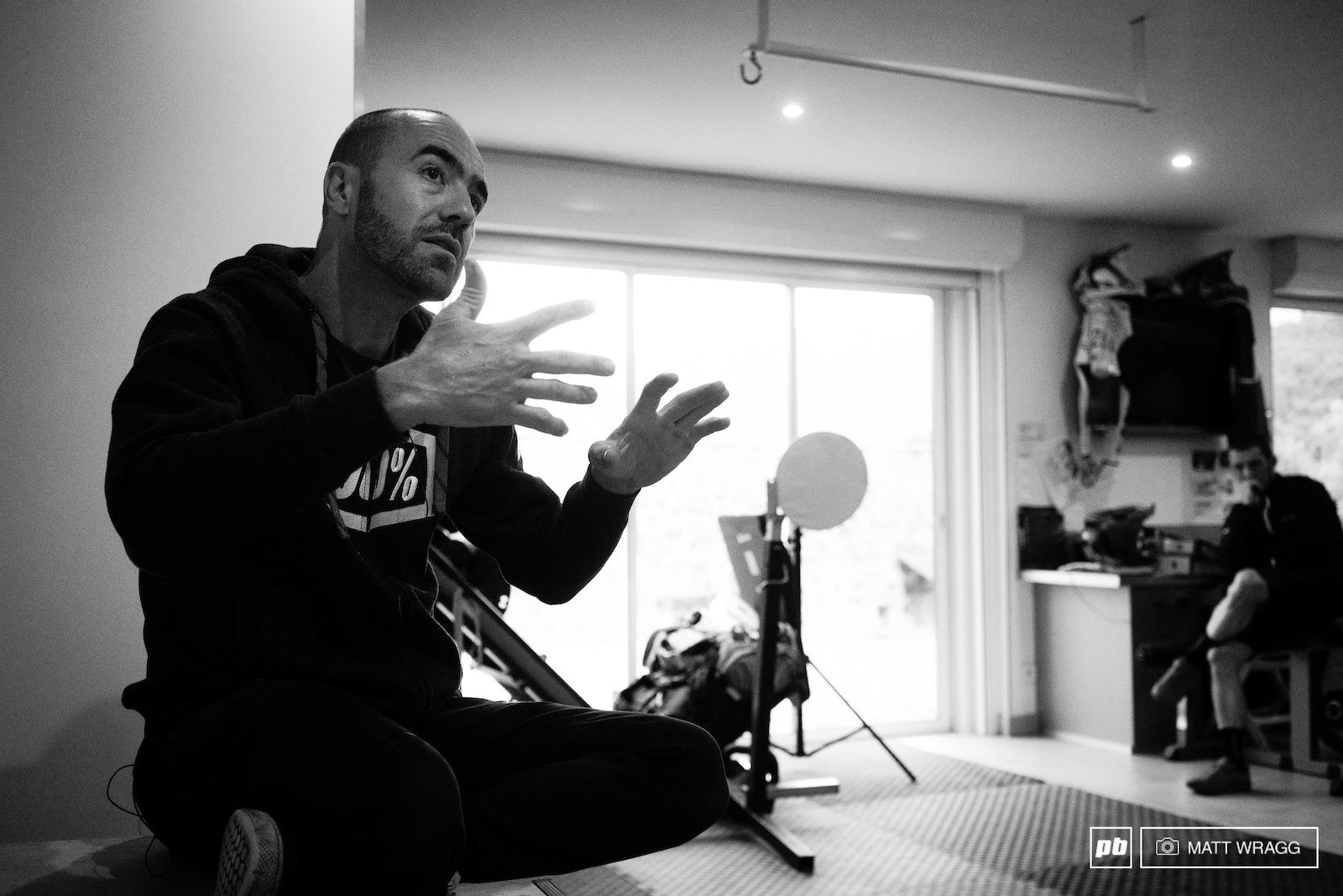
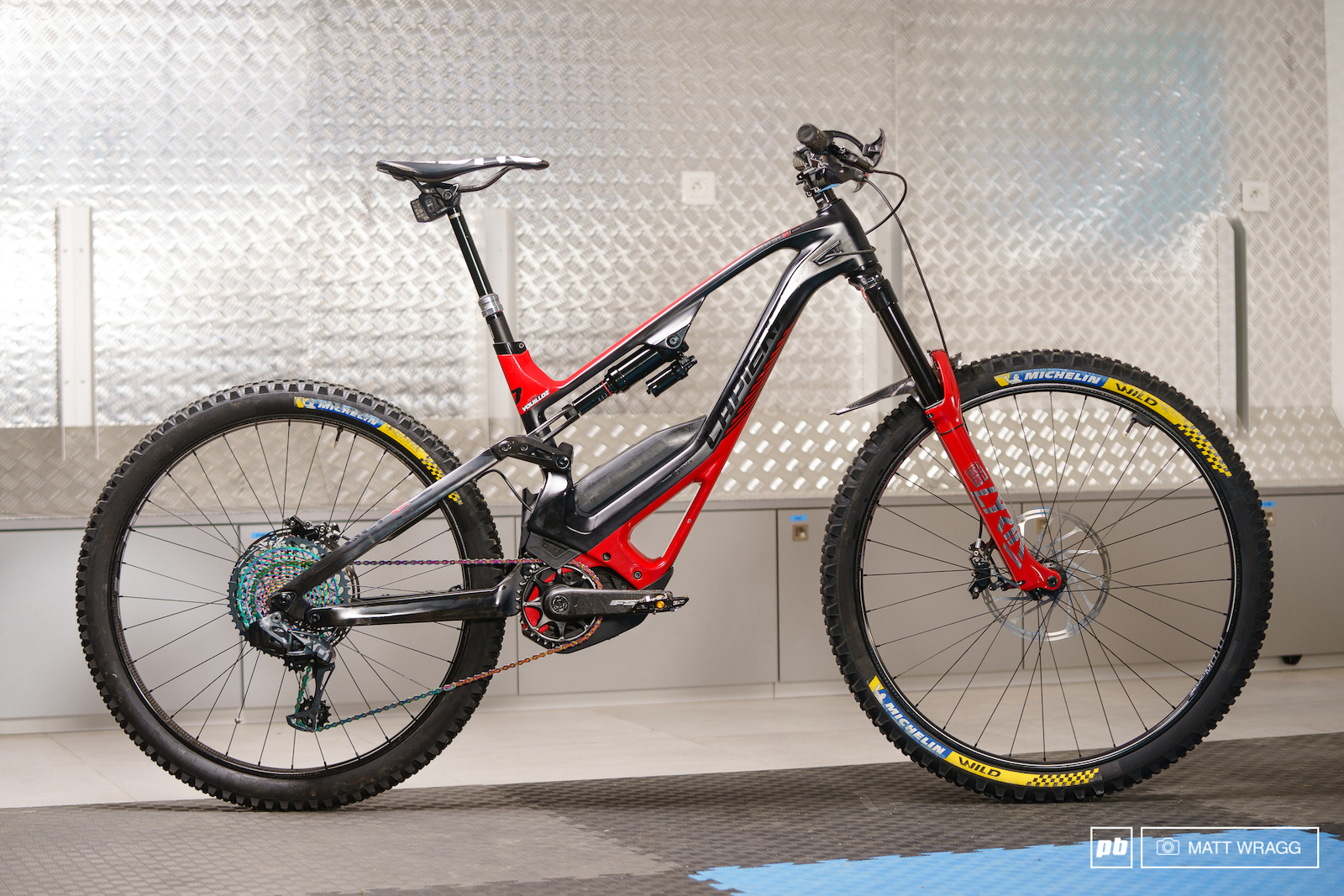

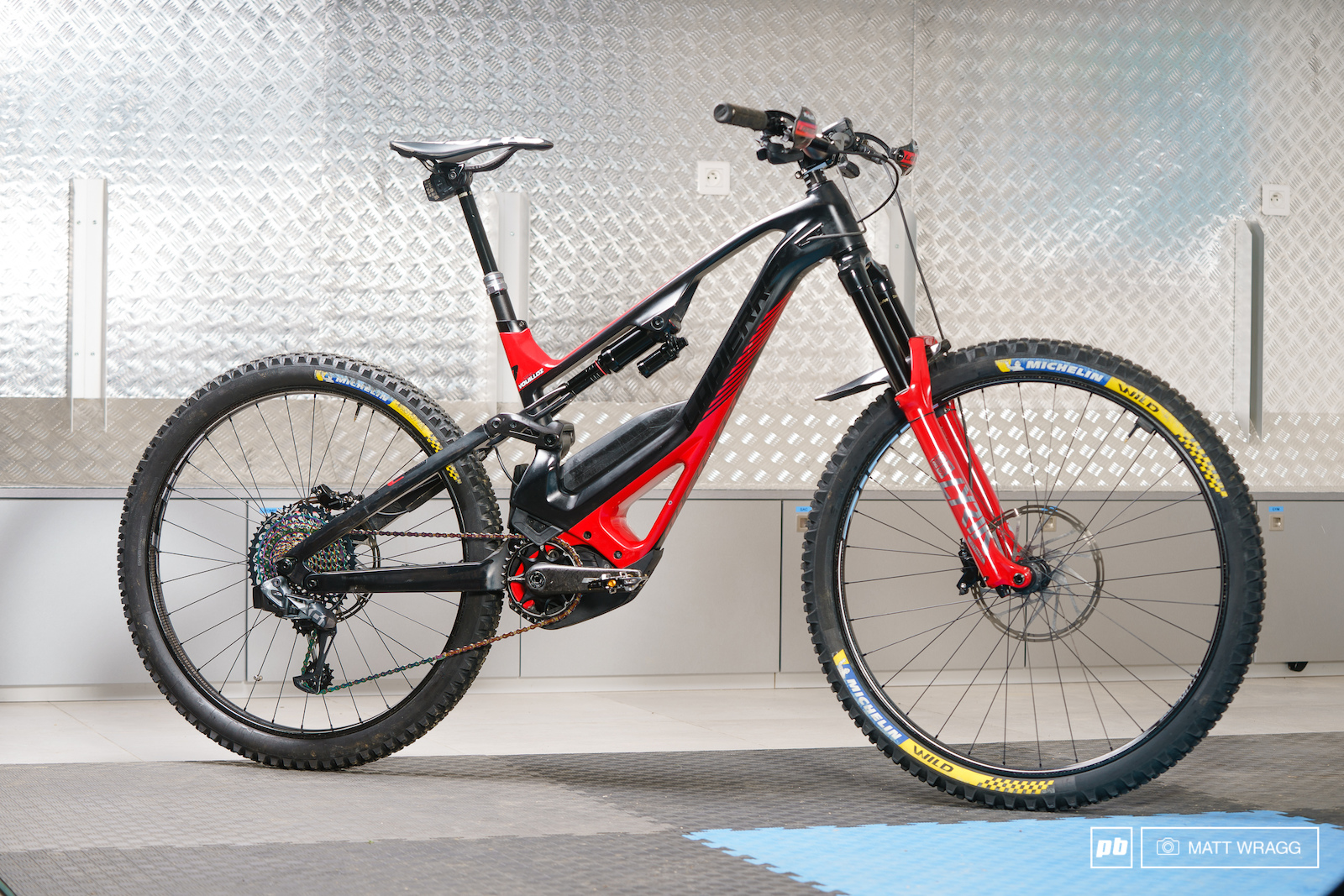

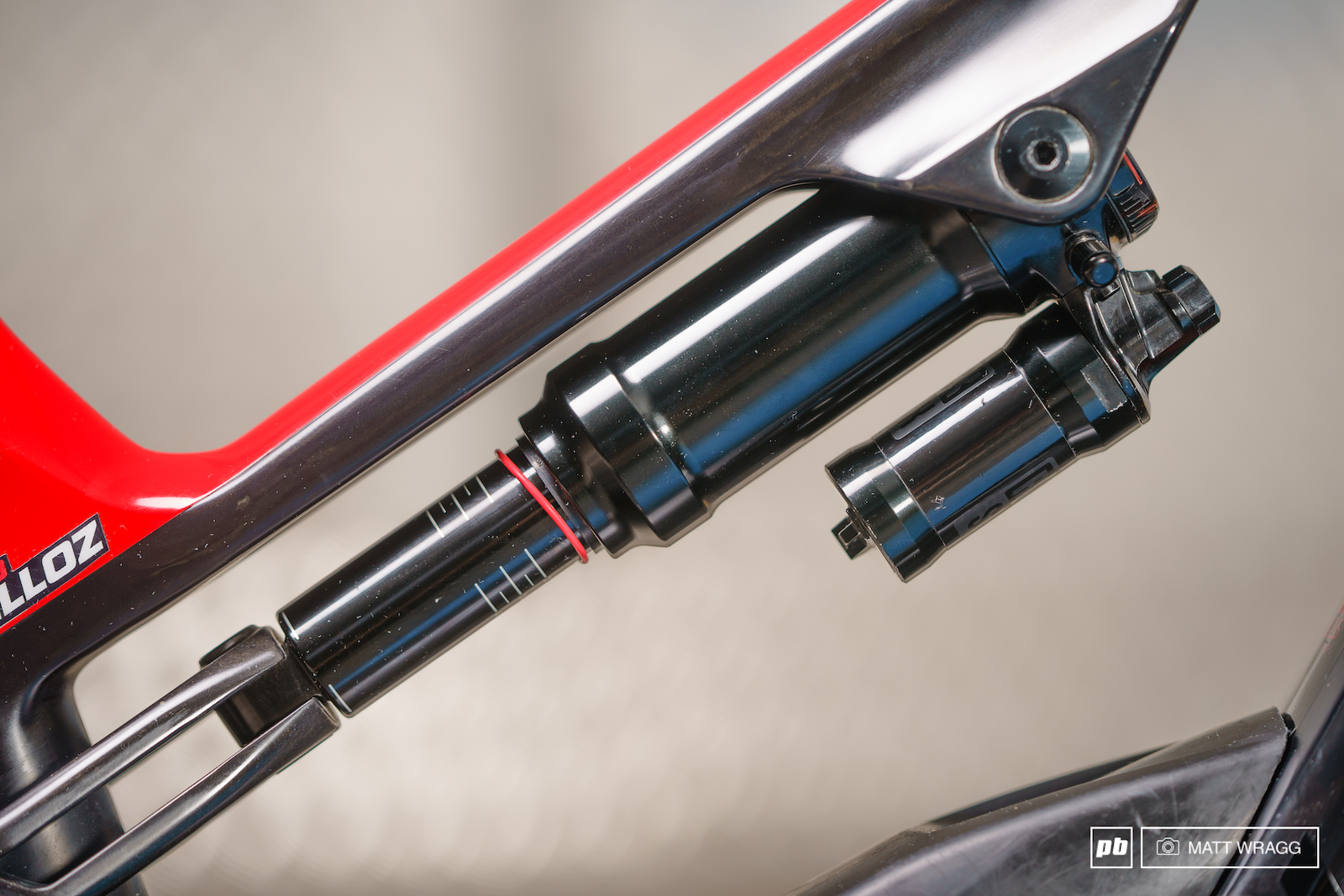


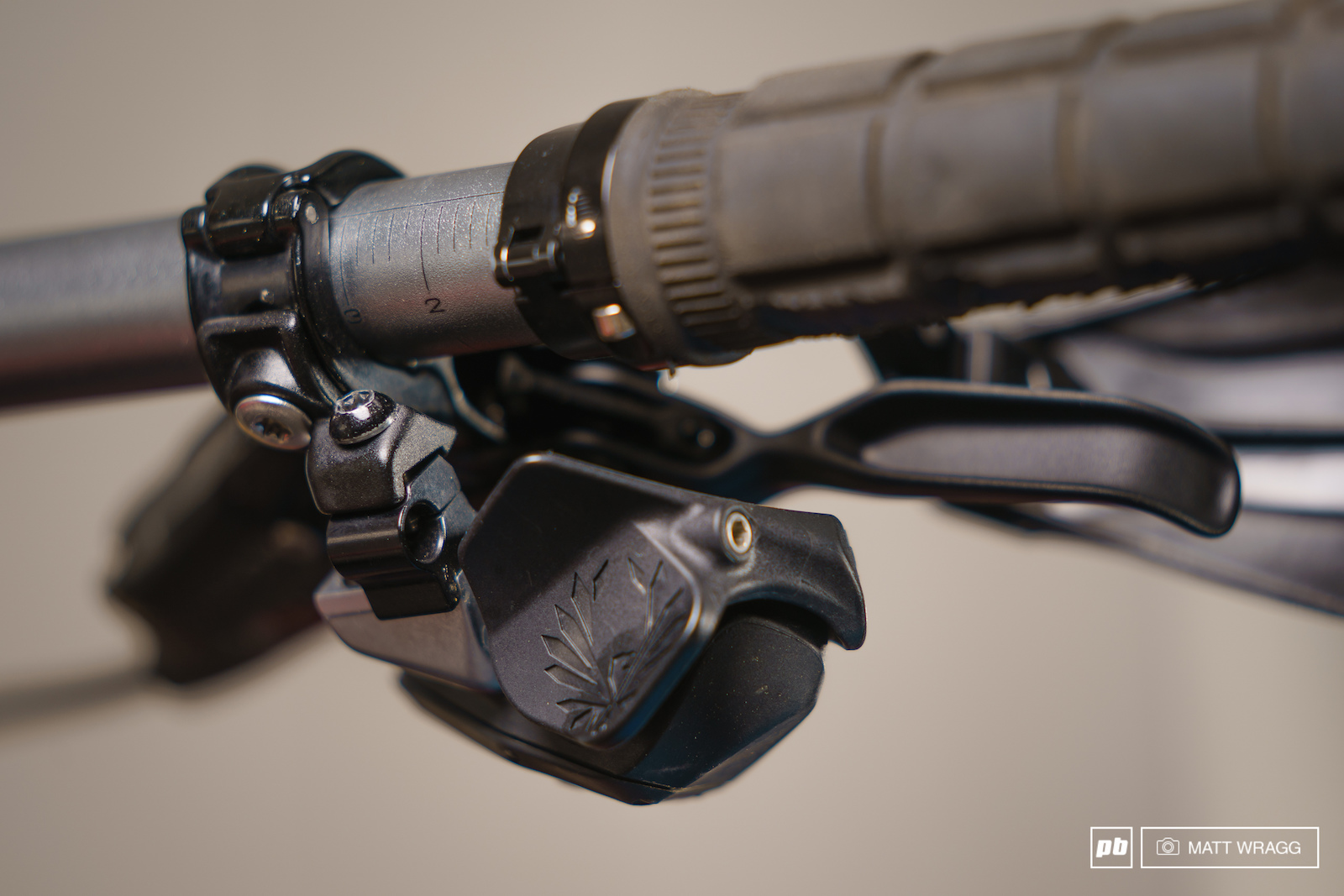
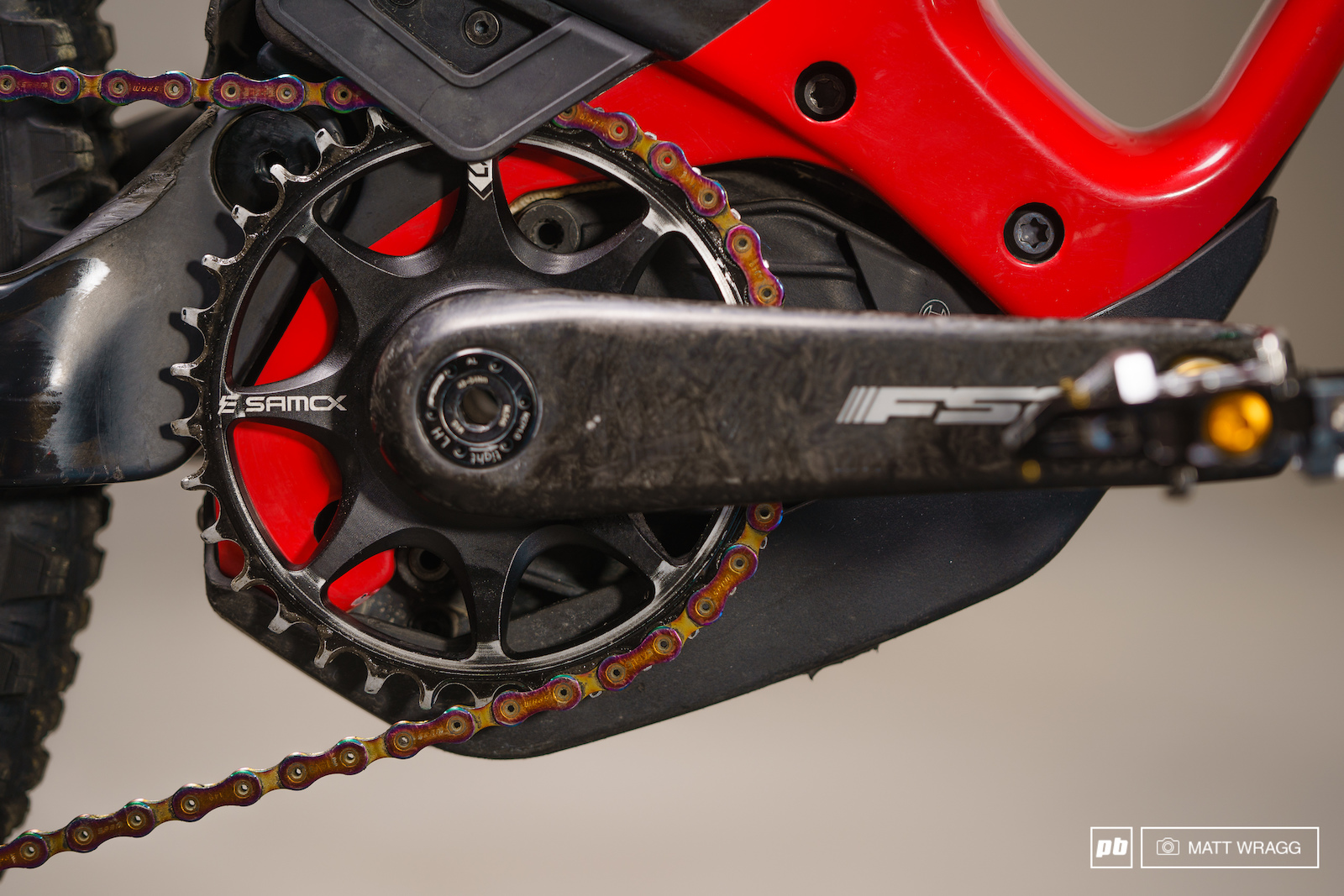



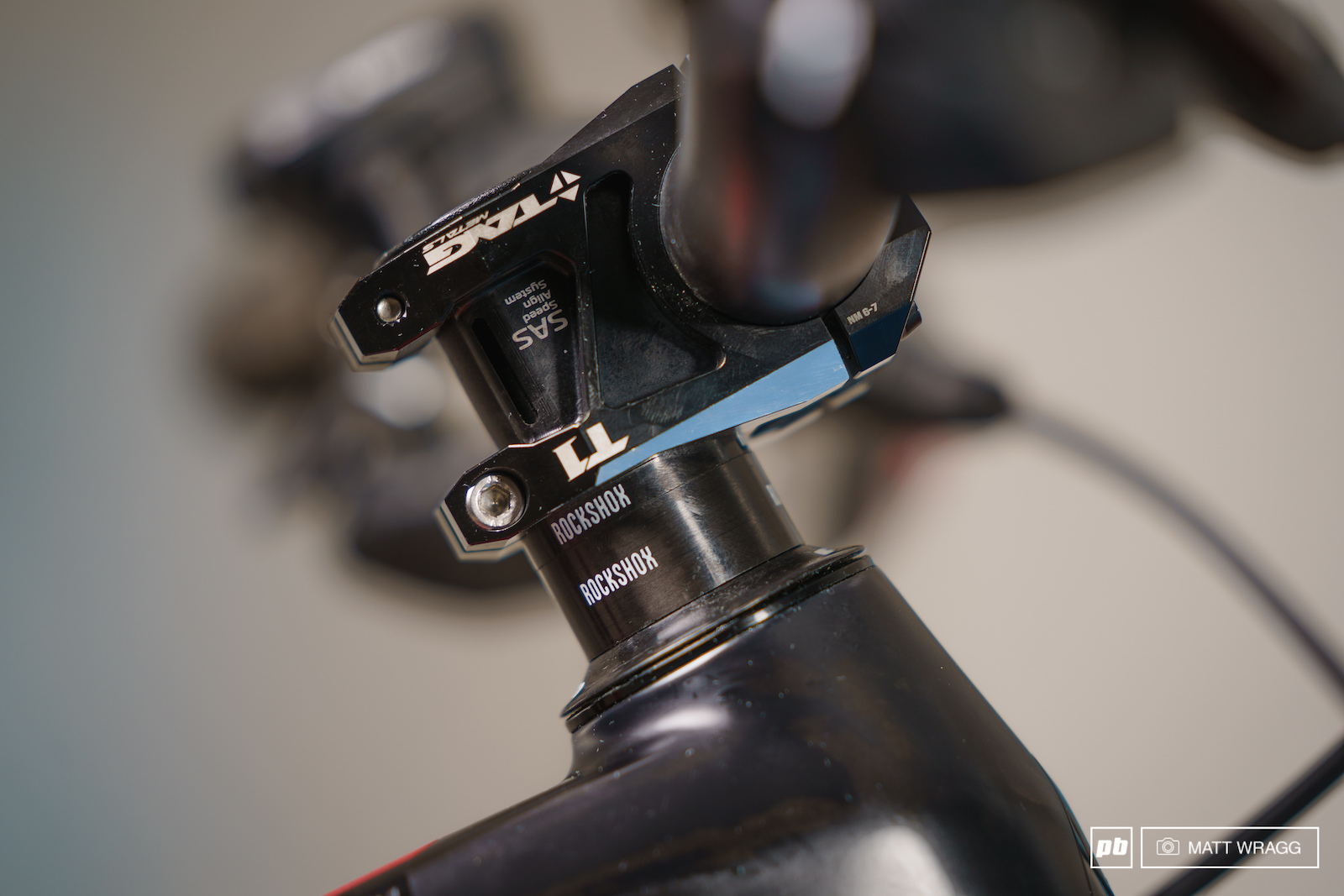

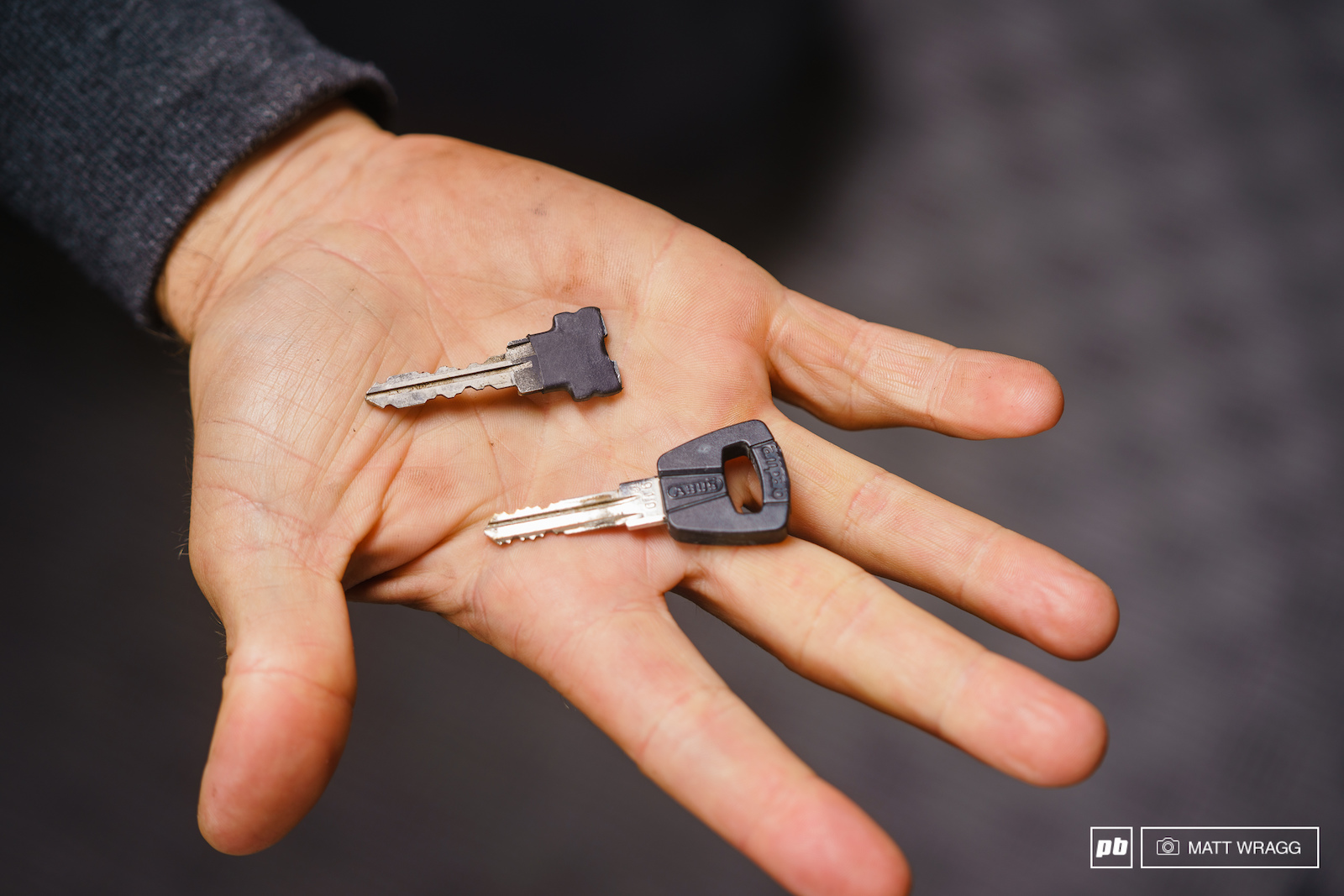

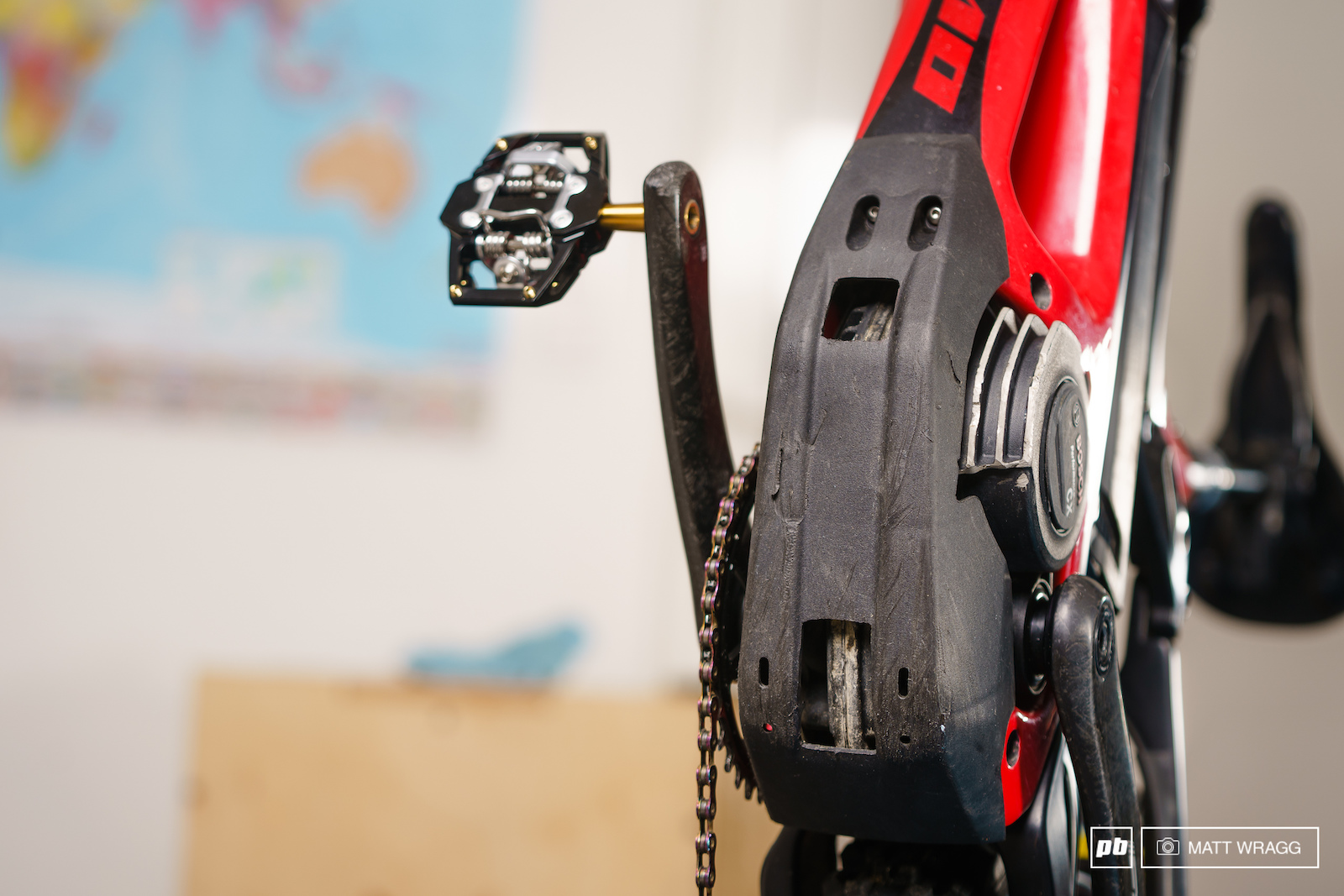
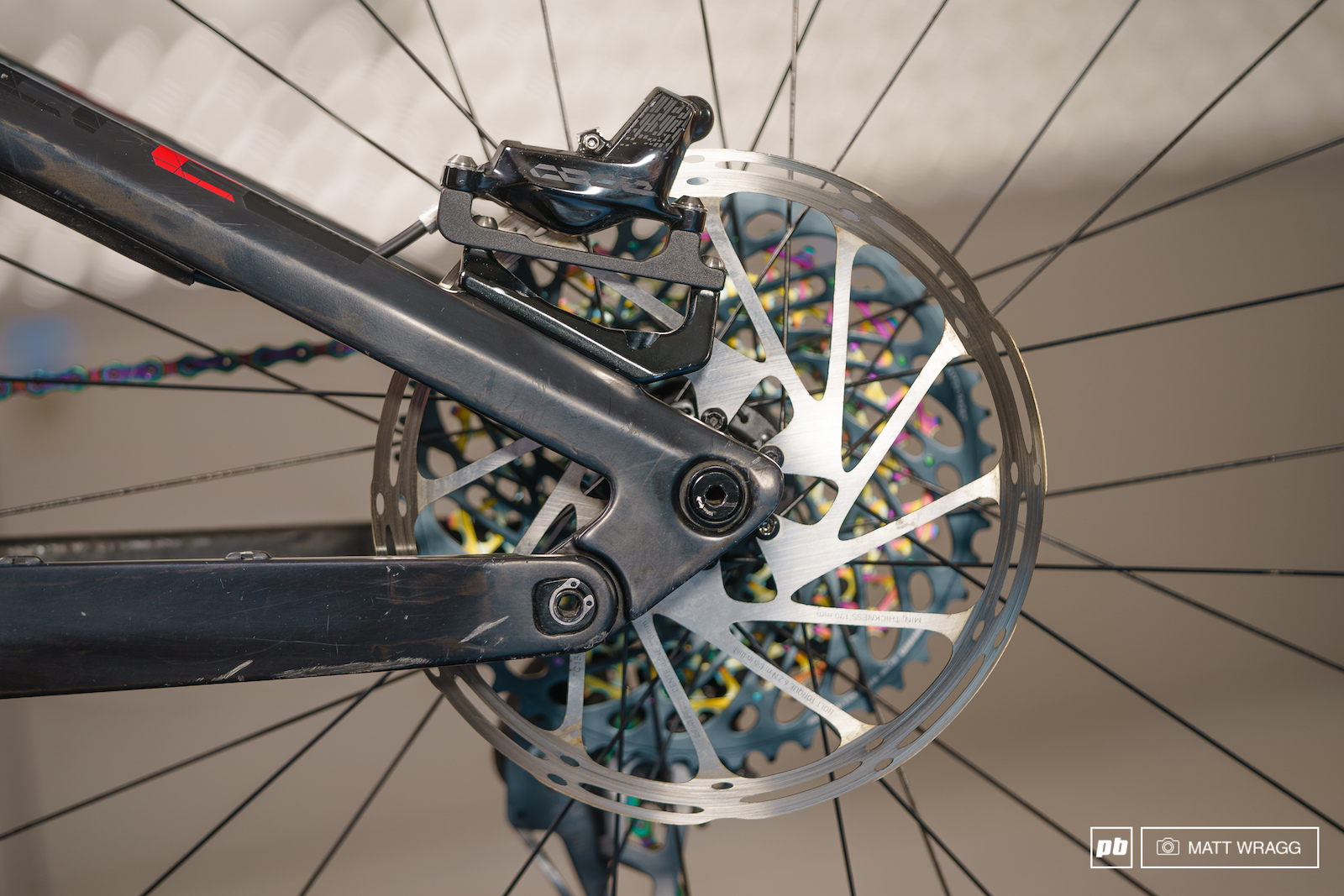

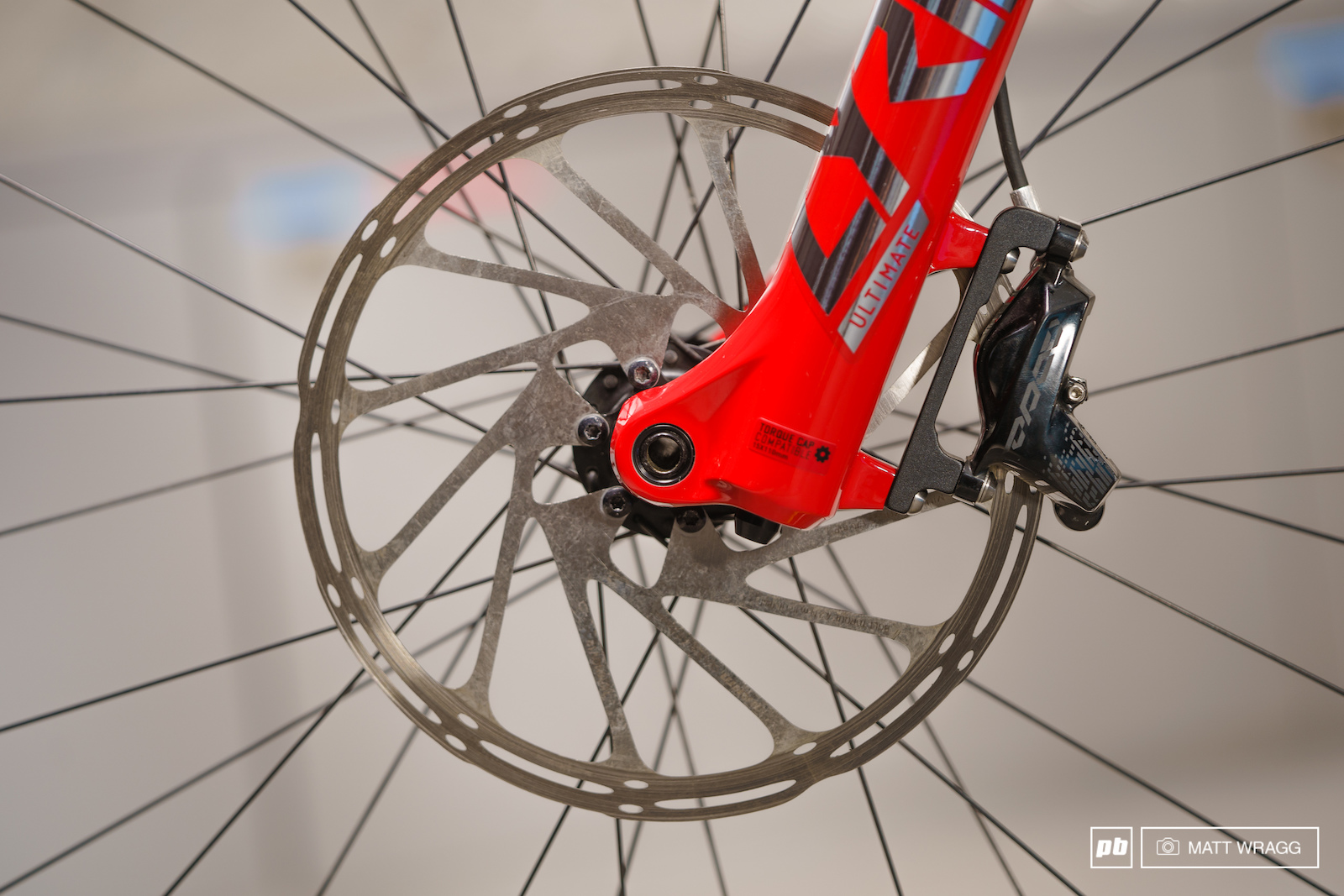
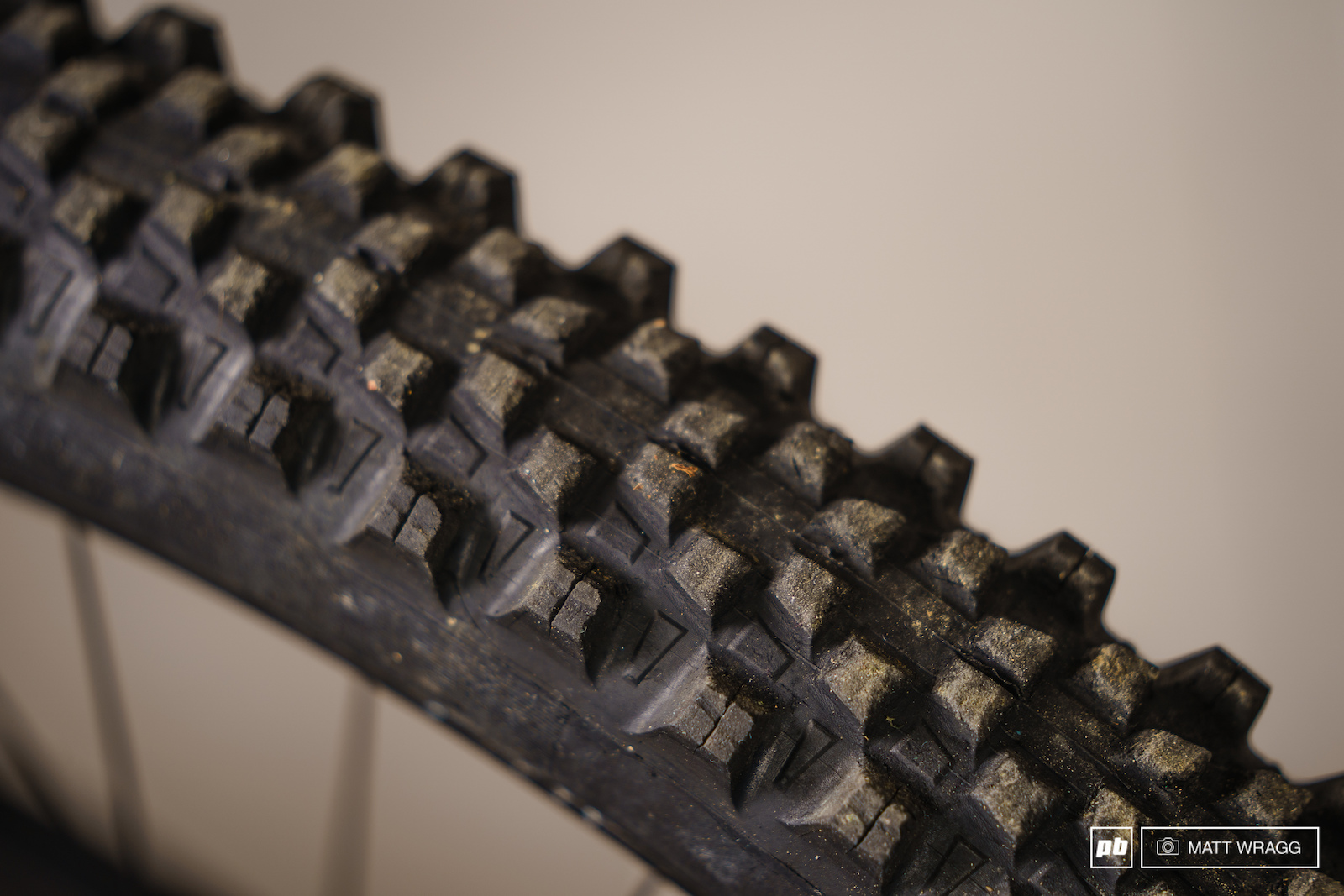

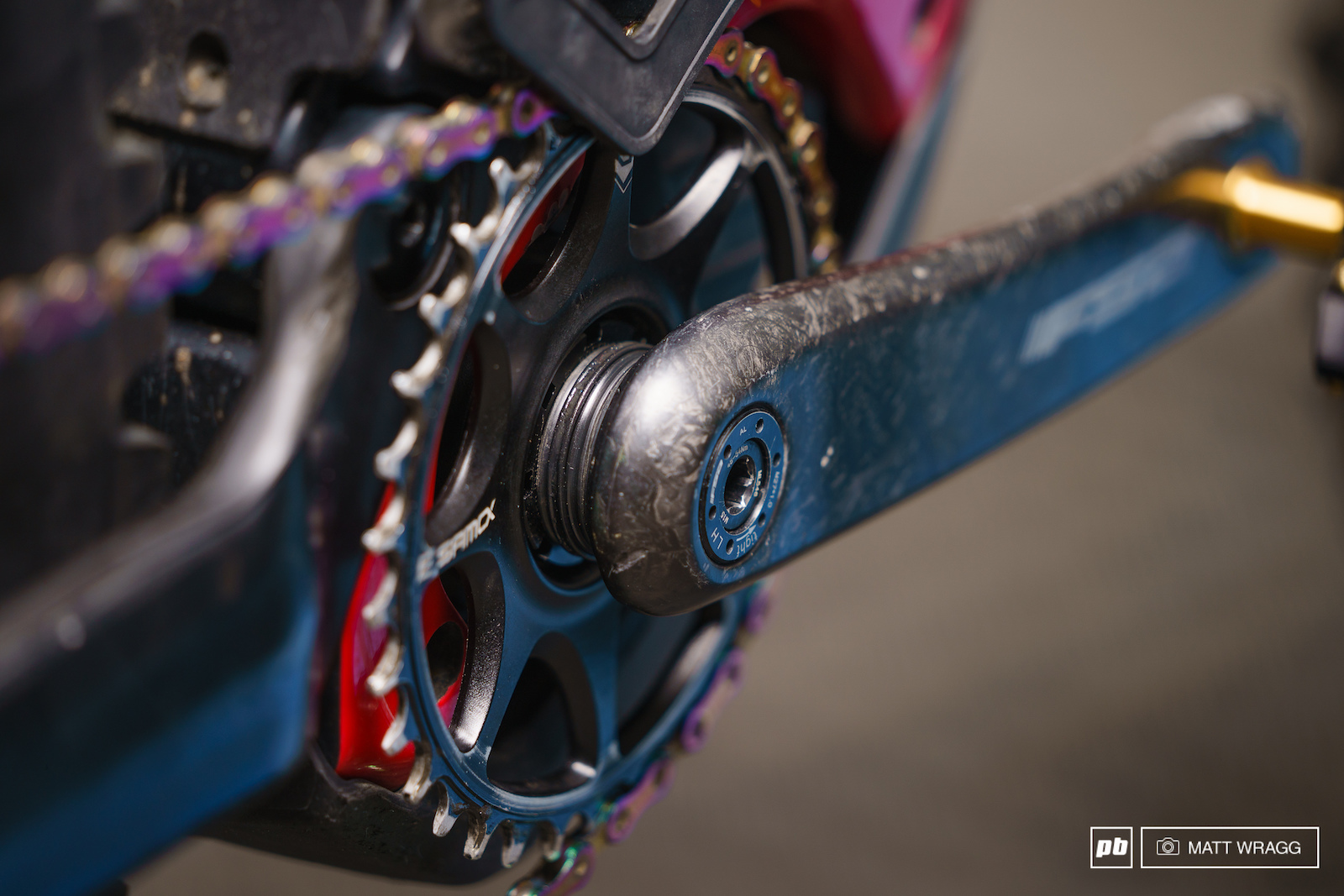

What I find most impressive about his riding career, even more than the number of things he won, is the number of world championships he lost.... one. Out of 11 that he entered. Because he flatted about halfway down the course. Still came 8th. Still has the humility to say things like this - "because if I feel we are on the edge with the stiffness with my weight and my ride style, I think people who are pushing more and are heavier, for sure they will be super happy with it."
Because there's heaps of people out there pushing harder than the guy who couldn't fall out of the top 10 at world champs even with a flat.
But I have to say, I see from your questions that sometimes I have understood differently. Maybe it's like a poem and everyone can take out some wisdom for himself?
Finally I've got something in common with one of the greats.
If you project a line from your steering axis to the ground, you'll find it lies in front of the contact patch of the wheel. This is your trail. In general, more trail = more stability (ie less twitchy).
So if you add MORE offset to your fork, what does this do?
We'll it doesn't change where your steering axis intersects the ground, BUT if does more your contact patch forward (ie it moves your axle forward and so your wheel forward) with respect to your steering axis giving you LESS trail. Which I think is why generally, more offset = more twitchy...
But to address your question, you're confused because you're using "stability" to refer to two completely different phenomena. The "stability" that you get with a longer fork offset is pitch stability, ie. fore/aft stability, which is stability in a straight line over rough terrain. That's what Nico is talking about with the "stability" of the longer wheelbase with longer offset.
The "stability" that you get with shorter offset is stability at turn in, ie. the bike will need more rider input to change direction, which is mostly noticed as stability from the initiation point to the apex of a corner. As you'd expect, the idea here is not go get the "most" stability, it's to get the "correct" amount of stability to achieve the desired turn in feel.
This is, of course, all things being equal, which they almost never are. Stem length, handlebar shape, and handlebar roll angle make a BIG difference. So does weight distribution, suspension action, HTA, and, basically, the "whole system".
One way to consider if reduced offset is better for any given bike; is when the HA falls bellow 65.5 deg., adding into account the component's dimensions, listed above and type of terrain one rides mostly.
Example- bike with longer TT, wider Bar ,shorter Stem lengths:
A. 65.5 + deg. HA with 44 mm offset = less stable or twitchy
B. 65.5 - deg. HA with 44 mm offset = very stable or far less twitchy (sweet spot)
C. Steeper HA above 66 deg. combined with shorter TT length, will typically render better handling with a 51 mm offset, such as used on Pivot Bicycles
(* The Caster Effect has more self correcting capability's in example B. and C.)
A good in-depth explanation, link below.
www.youtube.com/watch?v=wgHX7siJwso
The different offsets can be negligible in some cases.
It really would be cool if someone did a documentary style series of what was happening behind the scenes. "The race within the race" @Mattwragg eat your heart out. I feel that today, we have access to 85% of what the pro's are racing and in general, riders are much more informed. For instance, most of us could follow and make sense of the article, While back in the 90's we were mostly just riding stuff borrowed from XC and road. While the pro's were really figuring it out for themselves although not everyone had the backing and faith of sponsors to really listen to the riders? I feel there is probably a great story just in that.
If you like the idea of HANDGUARDS check out www.geohandguards.com they “PROTECT”- “DEFLECT” and “ABSORB” most impacts on the trail and are far superior to the AVS guards shown on his bike. Get “A HELMET FOR YOUR HANDS” today with free shipping!
HANDGUARDS and E BIKES are a match made in heaven when you consider the increased speeds and weight of a E BIKE!
Ride SMART- Ride SAFE! “GEO”